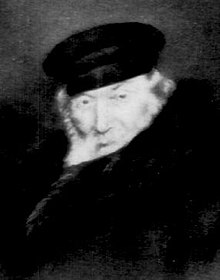Yisrael Meir Kagan
| Israel Meir Kagan | |
|---|---|

Age 91, on his visit to the Polish Prime Minister
|
|
| Personal details | |
| Born |
January 26, 1839 (11 Shevat 5599) Dzyatlava, Grodno Governorate, Russian Empire |
| Died | September 15, 1933 (aged 94) (24 Elul 5693) Radun', Poland |
| Signature |  |
Israel Meir (HaKohen) Kagan (January 26, 1839 – September 15, 1933), known popularly as the Chofetz Chaim (Hebrew: חפץ חיים, Hafetz Chaim), was an influential rabbi of the Musar movement, a Halakhist, posek, and ethicist whose works continue to be widely influential in Jewish life.
Kagan was born in Dzyatlava, Grodno Governorate, Russian Empire (today Belarus), on January 26, 1839, and died in Radun', Wilno Province in Poland (now Belarus) on September 15, 1933. His surname, Poupko, is not widely known. His home town, Dzyatlava, was once named Zdzięcioł when it was part of the Polish-Lithuanian Commonwealth until the time of the partitions of Poland. When Kagan was ten years old, his father died. His mother moved the family to Vilnius in order to continue her son's education. While in Vilnius, Kagan became a student of Rabbi Jacob Barit. Kagan's mother later remarried (Epstein) and moved to Radin. At 17, he married the daughter of his stepfather, and settled in Radin.
He served as the town rabbi of Radin for a short period. He then resigned from this position to establish the yeshiva in the city, which eventually became world-famous. By all accounts he was a modest and humble man. For a while he had a shop selling household provisions, which his wife managed. However, the business was not successful and he turned to teaching in order to support himself and his family. From 1864 to 1869 he taught Talmud in Minsk and Washilishok.
In 1869, he formed a Yeshiva in Radin. The Yeshiva was a success and grew to prominence, later becoming known as "Yeshivas Chofetz Chaim of Radin". In addition to spreading Torah through his yeshiva, Kagan, who became known as the Chofetz Chaim, was very active in Jewish causes. He traveled extensively to encourage the keeping of the Mitzvot amongst Jews. He became one of the most influential rabbis within Orthodox Judaism during the late 19th and early 20th century, taking a central leadership role in the World Agudath Israel movement in Eastern Europe.
...
Wikipedia
